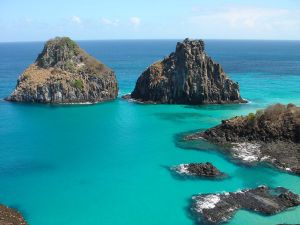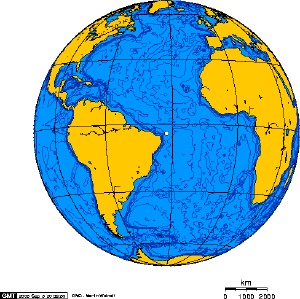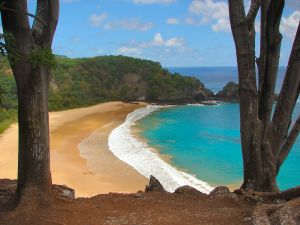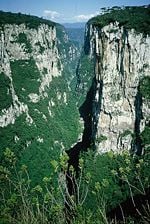Difference between revisions of "Fernando de Noronha" - New World Encyclopedia
Mary Anglin (talk | contribs) m (→External links) |
Mary Anglin (talk | contribs) (move section) |
||
| Line 15: | Line 15: | ||
'''Fernando de Noronha''' is an [[archipelago]] in the [[Atlantic Ocean]], part of the [[Pernambuco|State of Pernambuco]], around 354 km offshore from the [[Brazil]]ian coast. Its area is 18.4 km², its population 2,051 (2000). The area is a special [[municipality]] (''distrito estadual'') of the [[States of Brazil|Brazilian state]] of [[Pernambuco]]. Its [[timezone]] is [[UTC]]−2[[hour|h]]. The position is {{coord|03|54|S|32|25|W|region:BR-PE_type:isle}}. | '''Fernando de Noronha''' is an [[archipelago]] in the [[Atlantic Ocean]], part of the [[Pernambuco|State of Pernambuco]], around 354 km offshore from the [[Brazil]]ian coast. Its area is 18.4 km², its population 2,051 (2000). The area is a special [[municipality]] (''distrito estadual'') of the [[States of Brazil|Brazilian state]] of [[Pernambuco]]. Its [[timezone]] is [[UTC]]−2[[hour|h]]. The position is {{coord|03|54|S|32|25|W|region:BR-PE_type:isle}}. | ||
| + | |||
| + | == History == | ||
| + | Many controversies mark the archipelago's discovery by [[Europe]]ans. From its original name, ''Ilha da Quaresma'' ([[Lent]] Island), it was sighted by expeditions in the years 1501, 1502 and 1503. The [[Viscount]] of [[Santarém, Portugal|Santarém]], however, attributed the discovery to [[Gaspar de Lemos]], captain of the supply ship of [[Pedro Álvares Cabral]]'s fleet, sent back to [[Portugal]] with news of the discovery of [[Brazil]]. Modern historians, however, credit the 1501-1502 expedition led by [[Fernão de Noronha]] with the discovery of the archipelago. | ||
| + | |||
| + | The first to actually describe the island was [[Amerigo Vespucci (explorer)|Amerigo Vespucci]], who traveled with a [[Portugal|Portuguese]] expedition of [[Gonçalo Coelho]] to [[Brazil]] in the year 1503. In 1534, the Fernando de Noronha Archipelago was invaded by the [[England|English]], and from 1556 until 1612, it was held by the [[France|French]]. In 1628, it was occupied by the [[Netherlands|Dutch]], who were displaced two years later by a [[Spain|Spanish]]-Portuguese military expedition led by [[Rui Calaza Borges]]. The Dutch occupied the island once again in 1635, making it a hospital for their troops who occupied Northeastern Brazil (the Brazilian coast between Rio São Francisco and Maranhão). The island became known as ''[[Pavonia]]'', in honor of [[Michael Reyniersz Pauw|Michiel de Pauw]], one of the directors of the [[Dutch West Indies Company]]. It would remain under Dutch control for nearly twenty years, when it was reconquered by Portugal. | ||
| + | |||
| + | Finding it uninhabited and completely abandoned in 1736, the [[French East Indies Company]] took the island and renamed it Isle Dauphine. | ||
| + | Only from 1737 on, after the expulsion of the French, Fernando de Noronha was definitively occupied by Portugal. This time it was decided to fortify the island. For this purpose, ten forts were built in all strategic points where a possibility of disembarkation existed; nine in the main island and one in the Ilha de São José situated in front of the Saint Anthony harbor. The forts were connected by a network of stone roads. This defense system was planned by the Portuguese military engineer [[Diogo da Silveira Veloso]]. Around 1770, the first permanent settlement, [[Vila dos Remédios]], was founded. The village was divided in two units (pátios); in the superior one were the administrative buildings, in the lower one the church and the associated religious buildings. | ||
| + | |||
| + | As Brazil became independent, very little changed for Fernando de Noronha. | ||
| + | |||
| + | At the beginning of the 20th century, the [[United Kingdom|British]] arrived to provide technical cooperation in [[telegraphy]] (''The [[South American Company]]''). Later the French came with the ''[[French Cable]]'' and the Italians with ''[[Intalcable]]''. In 1942, during [[World War II]], the archipelago was made a [[Federal Territory]] that also included [[Rocas Atoll]] and [[Saint Peter and Paul Rocks]], and political and ordinary prisoners were sent to the local prison. In 1988 approximately 70% of the archipelago was declared a maritime [[national park]], with the goal of preserving the land and sea environment. On [[October 5]], [[1988]], the Federal Territory was dissolved and added to the state of [[Pernambuco]] (except Rocas Atoll, which was added to the state of [[Rio Grande do Norte]]). | ||
| + | |||
| + | |||
| + | Nowadays, Fernando de Noronha's economy depends on [[tourism]], restricted by the limitations of its delicate [[ecosystem]]. In addition to the historical interest noted above, the archipelago has been the subject of the attention of various scientists dedicated to the study of its [[Flora (plants)|flora]], [[Fauna (animals)|fauna]], [[geology]], etc. | ||
| + | |||
| + | In 2001, [[UNESCO]] declared Fernando de Noronha, with Rocas Atoll, a [[World Heritage Site]]. | ||
==Geology== | ==Geology== | ||
| Line 37: | Line 54: | ||
Fernando de Noronha is considered the best [[scuba diving]] place in Brazil.{{Fact|date=February 2008}} Warm water and exuberant subaquatic fauna and flora can be found in dives from 25 to 40 m deep. A Brazilian warship, the [[corvette]] [[NAeL Ipiranga]], sank in 1987 and is lying in pristine condition at around 190 feet. | Fernando de Noronha is considered the best [[scuba diving]] place in Brazil.{{Fact|date=February 2008}} Warm water and exuberant subaquatic fauna and flora can be found in dives from 25 to 40 m deep. A Brazilian warship, the [[corvette]] [[NAeL Ipiranga]], sank in 1987 and is lying in pristine condition at around 190 feet. | ||
| − | |||
| − | |||
| − | |||
| − | |||
| − | |||
| − | |||
| − | + | ==Conservation and environmental threats== | |
| − | |||
| − | |||
[[Image:FernandoDeNoronhaPraiaSancho.jpg|thumb|right|Praia Sancho, beyond this beach a reserve for some 600 spinner dolphins is established.]] | [[Image:FernandoDeNoronhaPraiaSancho.jpg|thumb|right|Praia Sancho, beyond this beach a reserve for some 600 spinner dolphins is established.]] | ||
| − | |||
| − | |||
| − | |||
| − | |||
| − | |||
Most of the original vegetation was cut down in the 19th century, when the island was used as a prison, to keep the prisoners from hiding and making rafts. | Most of the original vegetation was cut down in the 19th century, when the island was used as a prison, to keep the prisoners from hiding and making rafts. | ||
Revision as of 22:11, 7 November 2008
| Brazilian Atlantic Islands: Fernando de Noronha and Atol das Rocas Reserves* | |
|---|---|
| UNESCO World Heritage Site | |

| |
| State Party | |
| Type | Natural |
| Criteria | vii, ix, x |
| Reference | 1000 |
| Region** | Latin America and the Caribbean |
| Inscription history | |
| Inscription | 2001 (25th Session) |
| * Name as inscribed on World Heritage List. ** Region as classified by UNESCO. | |
Fernando de Noronha is an archipelago in the Atlantic Ocean, part of the State of Pernambuco, around 354 km offshore from the Brazilian coast. Its area is 18.4 km², its population 2,051 (2000). The area is a special municipality (distrito estadual) of the Brazilian state of Pernambuco. Its timezone is UTC−2h. The position is .
History
Many controversies mark the archipelago's discovery by Europeans. From its original name, Ilha da Quaresma (Lent Island), it was sighted by expeditions in the years 1501, 1502 and 1503. The Viscount of Santarém, however, attributed the discovery to Gaspar de Lemos, captain of the supply ship of Pedro Álvares Cabral's fleet, sent back to Portugal with news of the discovery of Brazil. Modern historians, however, credit the 1501-1502 expedition led by Fernão de Noronha with the discovery of the archipelago.
The first to actually describe the island was Amerigo Vespucci, who traveled with a Portuguese expedition of Gonçalo Coelho to Brazil in the year 1503. In 1534, the Fernando de Noronha Archipelago was invaded by the English, and from 1556 until 1612, it was held by the French. In 1628, it was occupied by the Dutch, who were displaced two years later by a Spanish-Portuguese military expedition led by Rui Calaza Borges. The Dutch occupied the island once again in 1635, making it a hospital for their troops who occupied Northeastern Brazil (the Brazilian coast between Rio São Francisco and Maranhão). The island became known as Pavonia, in honor of Michiel de Pauw, one of the directors of the Dutch West Indies Company. It would remain under Dutch control for nearly twenty years, when it was reconquered by Portugal.
Finding it uninhabited and completely abandoned in 1736, the French East Indies Company took the island and renamed it Isle Dauphine. Only from 1737 on, after the expulsion of the French, Fernando de Noronha was definitively occupied by Portugal. This time it was decided to fortify the island. For this purpose, ten forts were built in all strategic points where a possibility of disembarkation existed; nine in the main island and one in the Ilha de São José situated in front of the Saint Anthony harbor. The forts were connected by a network of stone roads. This defense system was planned by the Portuguese military engineer Diogo da Silveira Veloso. Around 1770, the first permanent settlement, Vila dos Remédios, was founded. The village was divided in two units (pátios); in the superior one were the administrative buildings, in the lower one the church and the associated religious buildings.
As Brazil became independent, very little changed for Fernando de Noronha.
At the beginning of the 20th century, the British arrived to provide technical cooperation in telegraphy (The South American Company). Later the French came with the French Cable and the Italians with Intalcable. In 1942, during World War II, the archipelago was made a Federal Territory that also included Rocas Atoll and Saint Peter and Paul Rocks, and political and ordinary prisoners were sent to the local prison. In 1988 approximately 70% of the archipelago was declared a maritime national park, with the goal of preserving the land and sea environment. On October 5, 1988, the Federal Territory was dissolved and added to the state of Pernambuco (except Rocas Atoll, which was added to the state of Rio Grande do Norte).
Nowadays, Fernando de Noronha's economy depends on tourism, restricted by the limitations of its delicate ecosystem. In addition to the historical interest noted above, the archipelago has been the subject of the attention of various scientists dedicated to the study of its flora, fauna, geology, etc.
In 2001, UNESCO declared Fernando de Noronha, with Rocas Atoll, a World Heritage Site.
Geology
The islands of this archipelago are the visible parts of a range of submerged mountains. Consisting of 21 islands, islets and rocks of volcanic origin, the main island has an area of 18 km², being 10 km long and 3.5 km at its maximum width. The base of this enormous volcanic formation is 756 m below the surface. The main island, from which the group gets its name, makes up 91% of the total area; the islands of Rata, Sela Gineta, Cabeluda and São Jose, together with the islets of Leão and Viúva make up the rest.
Climate
The climate is tropical, with two well defined seasons: the rainy season from January to August, and the dry season for the rest of the year. Unfortunately, the original land vegetation of the islands has been cut down, and nowadays is made up mostly of vines and bushes.
Flora
The island was mostly forested until the 19th century, when it was cleared to prevent prisoners from building rafts. The islands are now predominantly covered by shrublands, with some areas of secondary forest. Many of the plants currently prevalent on the island are introduced.
The United Nations Environment Program lists 15 possible endemic plant species, including species of the genera Capparis, (2 species) Ceratosanthes (3 species), Cayaponias (2 species), Moriordica, Cereus, Palicourea, Guettarda, Bumelia, Physalis, and Ficus noronhae [1]. Combretum rupicola is also a likely endemic.
Fauna
The islands have two endemic birds — the Noronha Elaenia (Elaenia ridleyana) and the Noronha Vireo (Vireo gracilirostris). Both are present on the main island; Noronha Vireo is also present on Ilha Rata. In addition there is an endemic race of Eared Dove Zenaida auriculata noronha. An endemic sigmodontine rodent, Noronhomys vespuccii, is now extinct. The islands have two endemic reptiles, Amphisbaena ridleyi and Mabuya maculata.
Marine life
The main attraction is the maritime flora and fauna; one can spot sea tortoises, dolphins, albatrosses, among many others.
Diving
Fernando de Noronha is considered the best scuba diving place in Brazil.[citation needed] Warm water and exuberant subaquatic fauna and flora can be found in dives from 25 to 40 m deep. A Brazilian warship, the corvette NAeL Ipiranga, sank in 1987 and is lying in pristine condition at around 190 feet.
Conservation and environmental threats
Most of the original vegetation was cut down in the 19th century, when the island was used as a prison, to keep the prisoners from hiding and making rafts.
Also, invasive species have been introduced:
- Linseed, intended for use as cattle feed.
- Tegu lizards (Tupinambis merianae, locally known as teju) introduced in the 1950s to control a rat infestation. Ironically, that didn't work out, because Tegus are diurnal and rats, nocturnal. Now the lizards themselves are considered a plague, feeding mostly on bird eggs. [2]
- Rock Cavies (Kerodon rupestris, locally known as mocó) introduced by the military in the 1960s as hunting game for soldiers. [3]
Resources
- Darwin, Charles, W. Botting Hemsley, Henry Nicholas Ridley, and Linn M. Smith. 1994. Charles Darwin visits Fernando Noronha: an illustrated narrative of one day during the voyage of H.M.S. "Beagle" with particular emphasis on the plants collected : based on his diary, journal, plant notes, and herbarium specimens. Northampton, Massachusetts: Old Leaf Press.
- National Geographic Society. Fernanda de Noronha-Atol das Rocas moist forests (NT0123) Retrieved November 7, 2008.
- Pousada do Frances. Fernando de Noronha - Brazil Retrieved November 7, 2008.
- Secchin, Carlos, and Clóvis Barreira e Castro. 1987. Arquipélago de Fernando de Noronha. Rio de Janeiro, RJ, Brasil: Cor/Ação. ISBN 9788585058036
- World Wildlife Fund. 2001. Fernando de Noronha-Atol das Rocas moist forests (NT0123) Retrieved November 7, 2008.
External links
All Links Retrieved November 7, 2008.
- Audio interview with Fernando de Noronha resident about life on Fernando de Noronha
- Site about islands in Brazil
- A photo tour of the island
- Photos of Fernando de Noronha by Alex Uchoa
- Administration of Pernambuco
- Tourist site in Spanish
Atlantic Forest South-East Reserves · Brasília · Central Amazon Conservation Complex · Chapada dos Veadeiros and Emas · Diamantina · Discovery Coast Atlantic Forest Reserves · Fernando de Noronha and Atol das Rocas · Goiás · Iguaçu · Olinda · Ouro Preto · Pantanal Conservation Area · Salvador de Bahia · Sanctuary of Bom Jesus do Congonhas · São Luís · Serra da Capivara
Shared with Argentina:Ruins of São Miguel das Missões (Jesuit Missions of the Guaranis)
| |||||||||||||||||||
Coordinates:
Credits
New World Encyclopedia writers and editors rewrote and completed the Wikipedia article in accordance with New World Encyclopedia standards. This article abides by terms of the Creative Commons CC-by-sa 3.0 License (CC-by-sa), which may be used and disseminated with proper attribution. Credit is due under the terms of this license that can reference both the New World Encyclopedia contributors and the selfless volunteer contributors of the Wikimedia Foundation. To cite this article click here for a list of acceptable citing formats.The history of earlier contributions by wikipedians is accessible to researchers here:
The history of this article since it was imported to New World Encyclopedia:
Note: Some restrictions may apply to use of individual images which are separately licensed.


